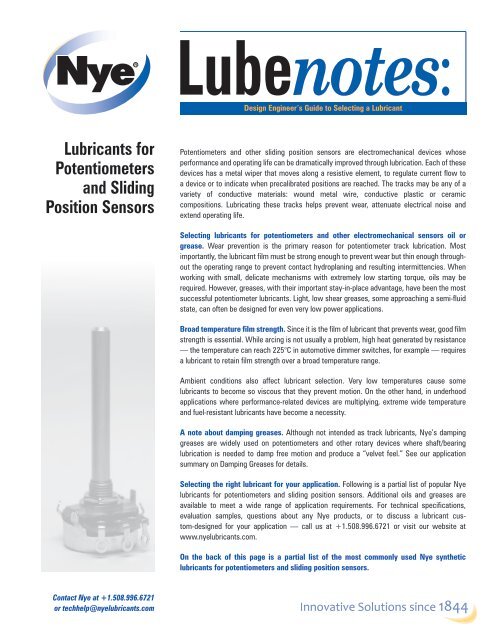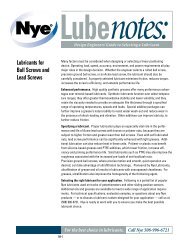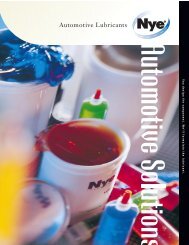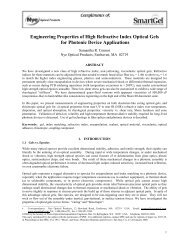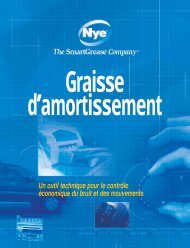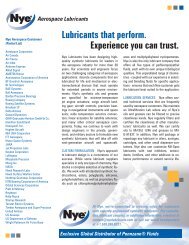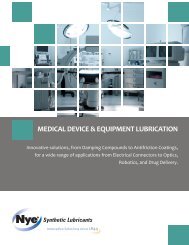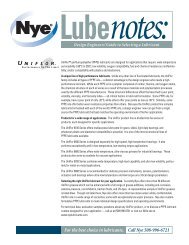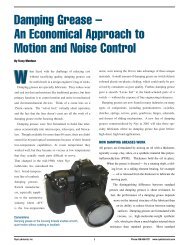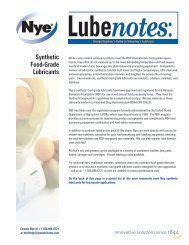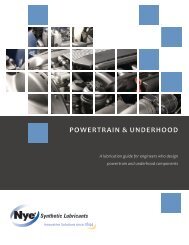Lubricants for Potentiometers and Sliding Position Sensors
Lubricants for Potentiometers and Sliding Position Sensors
Lubricants for Potentiometers and Sliding Position Sensors
You also want an ePaper? Increase the reach of your titles
YUMPU automatically turns print PDFs into web optimized ePapers that Google loves.
Lubenotes:Design Engineer’s Guide to Selecting a Lubricant<strong>Lubricants</strong> <strong>for</strong><strong>Potentiometers</strong><strong>and</strong> <strong>Sliding</strong><strong>Position</strong> <strong>Sensors</strong><strong>Potentiometers</strong> <strong>and</strong> other sliding position sensors are electromechanical devices whoseper<strong>for</strong>mance <strong>and</strong> operating life can be dramatically improved through lubrication. Each of thesedevices has a metal wiper that moves along a resistive element, to regulate current flow toa device or to indicate when precalibrated positions are reached. The tracks may be any of avariety of conductive materials: wound metal wire, conductive plastic or ceramiccompositions. Lubricating these tracks helps prevent wear, attenuate electrical noise <strong>and</strong>extend operating life.Selecting lubricants <strong>for</strong> potentiometers <strong>and</strong> other electromechanical sensors oil orgrease. Wear prevention is the primary reason <strong>for</strong> potentiometer track lubrication. Mostimportantly, the lubricant film must be strong enough to prevent wear but thin enough throughoutthe operating range to prevent contact hydroplaning <strong>and</strong> resulting intermittencies. Whenworking with small, delicate mechanisms with extremely low starting torque, oils may berequired. However, greases, with their important stay-in-place advantage, have been the mostsuccessful potentiometer lubricants. Light, low shear greases, some approaching a semi-fluidstate, can often be designed <strong>for</strong> even very low power applications.Broad temperature film strength. Since it is the film of lubricant that prevents wear, good filmstrength is essential. While arcing is not usually a problem, high heat generated by resistance— the temperature can reach 225°C in automotive dimmer switches, <strong>for</strong> example — requiresa lubricant to retain film strength over a broad temperature range.Ambient conditions also affect lubricant selection. Very low temperatures cause somelubricants to become so viscous that they prevent motion. On the other h<strong>and</strong>, in underhoodapplications where per<strong>for</strong>mance-related devices are multiplying, extreme wide temperature<strong>and</strong> fuel-resistant lubricants have become a necessity.A note about damping greases. Although not intended as track lubricants, Nye’s dampinggreases are widely used on potentiometers <strong>and</strong> other rotary devices where shaft/bearinglubrication is needed to damp free motion <strong>and</strong> produce a “velvet feel.” See our applicationsummary on Damping Greases <strong>for</strong> details.Selecting the right lubricant <strong>for</strong> your application. Following is a partial list of popular Nyelubricants <strong>for</strong> potentiometers <strong>and</strong> sliding position sensors. Additional oils <strong>and</strong> greases areavailable to meet a wide range of application requirements. For technical specifications,evaluation samples, questions about any Nye products, or to discuss a lubricant custom-designed<strong>for</strong> your application — call us at +1.508.996.6721 or visit our website atwww.nyelubricants.com.On the back of this page is a partial list of the most commonly used Nye syntheticlubricants <strong>for</strong> potentiometers <strong>and</strong> sliding position sensors.Contact Nye at +1.508.996.6721or techhelp@nyelubricants.comInnovative Solutions since 1844
Lubenotes:<strong>Lubricants</strong> <strong>for</strong> <strong>Potentiometers</strong> <strong>and</strong> <strong>Sliding</strong> <strong>Position</strong> <strong>Sensors</strong><strong>Lubricants</strong> <strong>for</strong> <strong>Potentiometers</strong><strong>and</strong> <strong>Sliding</strong> <strong>Position</strong> <strong>Sensors</strong>Temp Range (°C)Base OilViscosity at 40 °CApplicationsRheolube 716A -54 to 150 18.5 cSt Ester-based grease <strong>for</strong>tified with special additives toreduce electrical noise & wear in electrical contactapplications. Good wide-temp serviceability. Basefluid has excellent film strength <strong>for</strong> very high-loadapplications. Use with caution around ester-vulnerableplastics.UniFlor 8910 -70 to 225 90 cSt A medium viscosity perfluoropolyether oil intended<strong>for</strong> applications where temperature extremes,exposure to fuels or aggressive chemicals in theoperating environment would preclude the use ofmore traditional lubricants.UniFlor 8511S -50 to 225 65 cSt A PTFE thickened, medium viscosity, completelyfluorinated grease <strong>for</strong> use in high temperatureapplications exposed to fuels or aggressivechemicals. It possesses excellent thermo-oxidativestability <strong>and</strong> low vapor pressure characteristics.UniFlor 8951 -90 to 200 18 cSt Chemically resistant fluorinated grease with exceptionallow temperature capability & low-volatility.Useful where contact <strong>for</strong>ce is


